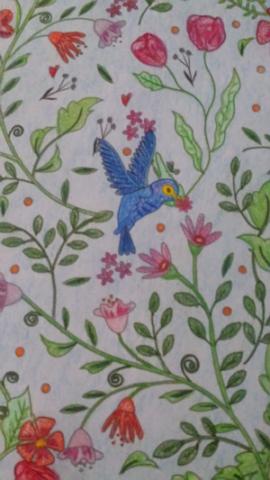What I Learned About Writing From Coloring Books
Apr 28,2016
I’ve joined the coloring book craze. I loved coloring when I was a kid, and as it happens I still love to color. I’ve always considered myself a wannabe crafter, and I used to dabble in painting with acryllics, and while coloring isn’t actually crafting or creating an original work of art, it still allows me to play with colors and create something pretty.
I’ve found that, at least for me, there is a meditation-like quality to coloring because the coloring itself is all I’m thinking about while I’m engaged in the activity. I’m not worried about schoolwork I have to do, crazy professors, and all the writing I have to get through. All I’m thinking about is the page I’m coloring, what colored pencils, crayons, or markers I want to use, and which colors I think will look best. It seems like the more I have to do, the more I appreciate the simplicity of sitting down with some crayons and filling in the pictures.
As coloring has become more popular, there have been many posts and articles about how to color, tips for coloring, that sort of thing. It’s similar to what happened with writing and indie publishing—suddenly there are a lot of experts around shouting about how to color the right way. Use this color combination, not that color combination! Now I have to learn how to shade, I have to have depth in my pictures, and my coloring pages should look museum ready. All of a sudden, something that should be relaxing and fun becomes stressful as we try to keep up with all of the expert tips telling us how to color. There’s nothing like an “expert” to take the fun out of something.
Finally, I had the realization (while coloring, of course) that my attitude toward coloring was the same as my attitude toward writing. I had to decide for myself how I wanted to color, just like I had to decide for myself how I wanted to write. Here are a few things I learned from coloring books and how they relate to writing:
1. Use the colors you want to use.
The experts in coloring books will tell you to choose your pallette first—use a color wheel to help you determine which colors you want to use. They’ll tell you which colors go with each other, and if you use that color combination, look out! The Crayola Police will hunt you down. Hey, they say, that’s how painters do it, so that’s how coloring people should do it too!
And then I realized that I could use any color combination I want, just as I can write my stories however I want. I don’t like choosing my colors ahead of time. I like to choose my colors one by one as I’m coloring in the picture. Sometimes I have an overall idea of the color scheme I want to use, sometimes I don’t. Sometimes I’m happy with how the pictures turn out, sometimes I’m not. When I’m writing, I have an overall idea of how I want the story to turn out, but I’ve also learned to get out of my own way and allow the story to find its own way. But if I prefer choosing my colors as I go along as opposed to choosing the then I can do that. If I prefer letting my stories find their own way, I can do that too.
2. Stop comparing yourself to others.
There are some amazing coloring websites out there where the coloring people post their finished pages. Some of those colored pages are indeed museum ready. They’re absolutely beautiful with shading and light and the way the colors blend together. My pictures don’t look like that (as you’ll see from the examples in this post). I love playing with colors, and some color combinations I try I like, some I don’t like as much, but so what? I wouldn’t know what I liked unless I allowed myself the freedom to experiment.
I’m not a professional artist, and I have no desire to become a professional artist. To make myself crazy trying to make my pictures look like some of these artists’ pictures doesn’t work for me. I don’t have a lot of time to color because I’m so busy with other tasks, so when I do have time to color I don’t want to spend my time being stressed because my picture doesn’t look good enough. Where’s the fun in that?
3. Outline if you want to (also known as coloring outside the lines).
When I was reading a few posts of coloring tips, a number of the experts said not to outline your drawing with your colored pencils. Apparently, the outlining means you’re not going to have a realistic-looking product and that’s not how the professional artists do it. Oh well. I’ve always liked to outline my coloring pictures. Even when I was a kid I’d outline the shapes with whatever crayon I was using. A lot of times, I’ll outline with a darker color and then fill in the shape with a lighter color, and I like the way that looks. It’s my own way to add interest to the picture (which I discovered while coloring as a kid). Is it wrong? Not to me. Like I said, I like the way it looks, and since it’s my coloring page I’m going to do it the way I want to do it. It’s the same with coloring outside the lines. I like it when my coloring pencils or crayons end up outside the line because then then I’m doing the next color they blend a bit. How maddening, to feel like your coloring page is all wrong if your hand slipped and some color ended up on the other side of the black line.
There are many posts out there for writers about how to do things. Write in these genres if you want to make money. Publish this many books a year. Set your books at these prices. Grow your social media presence and build your author platform. But what if your heart is calling you in a different direction? What if you don’t want to limit your writing to certain genres, or what if you have another life outside of your writing life like I do and you can only publish one book a year? Does that mean that you won’t have any career as a writer? Not at all. It means that you get to decide what kind of career you’re going to have. If I’ve learned anything over nearly five years as an author/publisher, it’s that I have to run my writing career the way I want to. I have to write my stories the way I want to write them, and if I color outside the lines with my words on occasion then I’m okay with that. That’s my way.
Here are my own tips for coloring (and they apply to writing as well):
1. Choose pictures you want to color. If you don’t love the picture, colorng it will be a chore. The same goes for writing. Write something you’re excited to get back to. If you’re not excited about it, it’s going to be hard to convince readers your writing is worth their time.
2. Choose your own colors. You can use a color wheel to examine which colors go together, or you can choose whatever you want to choose because you want to choose it. You can choose them ahead of time, or you can choose them in the moment. For writing, you get to decide how you use language. You get to decide how you’ll string phrases together. Some blends you may not like. That’s okay. You tried it, you didn’t like it, so try it again until you find something you do like.
3. Don’t compare your pictures (or your writing) to anyone else. Do your own thing. Find our own style.
4. Make coloring (and writing) fun. Listen to your favorite music. Turn off your electronic devices and other distractions. Make your coloring (and your writing) time special so you’re looking forward to getting back to it.
You can let the experts tell you what to do and how to do it, or you can find your own way. Whether I’m coloring or writing, I find it a lot more fulfilling to find my own way.






